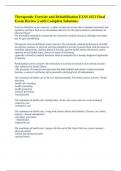Therapeutic Exercise and Rehabilitation EXSS 4351 Final
Exam Review || with Complete Solutions.
Exercise definition correct answers "a subset of physical activity that is planned, structured, and
repetitive, and has a final or an intermediate objective for the improvement or maintenance of
physical fitness"
-for the healthy population is generally not covered by medical insurance, although some plans
pay for gym membership
Therapeutic exercise definition correct answers "the systematic, planned performance of bodily
movements, postures, or physical activities intended to provide a patient/client with the means to
remediate impairments, improve physical function, prevent health-related risk factors, and/or
optimize overall health status, fitness, or sense of well-being"
-generally covered by medical insurance when accompanied by a therapy diagnosis/impairment
in function
Rehabilitation correct answers -the restoration of a person to normal or near normal function
after a physical or mental illness
-The processes of treatment and education that help disabled individuals to attain maximum
function, a sense of well-being, and a personally satisfying level of independence
The continuum of health care in the U.S: Staying Healthy: Prevention correct answers - Health
education
-health risk screening
-health counseling
-health promotion
-primary prevention
-immunization
The continuum of health care: Getting better: Acute care correct answers -acute treatment
-maternity care
-emergency care
The continuum of health care: Living with chronic illness and disability: Chronic care correct
answers - disease management
-secondary prevention
- rehabilitation
-long-term care
The continuum of health care: Coping with the end of life: End of life care correct answers -
physical comfort
-mental and emotional needs
-spiritual needs
,Short-Term acute hospitals (Acute Therapy) correct answers -What you most often think of
when you think "hospital"
-Where people go for illness, surgery
-Stays tend to be shorter
-Hospital may be
Long term acute hospitals (LTACH) correct answers -Specialize in the treatment and recovery of
patients with complex needs requiring prolonged length of stay (LOS)
-May be
-Freestanding
-"Hospital in Hospital" (HIH): on the grounds or in wing of an existing hospital
-Patient characteristics
-May require prolonged ventilation
-Multiple co-morbidities and secondary diagnoses
Inpatient rehabilitation facilities (IRF) correct answers -For physical rehabilitation (not mental
health/substance abuse)
-May be freestanding or within acute hospital
-Patient requirements
-Must be able to tolerate intensive (<3 hrs/day) of therapy and a minimum of 2 therapy
disciplines
-Must require 24-7 rehab nursing and close physician monitoring
-Typical LOS 2-4 weeks
Skilled nursing facilities (SNF/LTC Facility) correct answers -Often both long (indefinite) and
short-term (up to 100 days) residents
-May be free-standing or within hospital
-Types of residents
Assisted living facilities (ALF) correct answers -Housing facility for people with disabilities or
older adults who can't or choose not to live independently
-Residents often need assistance with some activities of daily living
-Housekeeping, bathing, meds, transportation, etc.
-A step away from retirement communities where residents are fully independent
-Special memory care facilities also exist for those with Alzheimer's or other dementia
-Therapy services are comparable to home health care, on as-needed basis
Outpatient rehabilitation correct answers -Need rehab services to address functional limitations
but don't require inpatient or home health care
-May be freestanding, part of rehab center or hospital
-Number of visits depends on cause(s) for decreased function
Home health care correct answers -Need ongoing skilled rehabilitation but no longer at the
intensity required for an inpatient setting
-Unable to get to an outpatient facility without "considerable and taxing effort"
-Must be "homebound", can only leave home for medical appointments or
, -Non-medical absence that is "short and infrequent in duration"
Ex: Religious service
Ex: Hair cut
Ex: Special family event
Prevention Programs correct answers -Fall prevention programs
-Car seat fittings
-Employer injury prevention programs
-Routine medical screening (e.g., pap smear)
Health promotion programs correct answers -Gyms/rec centers
-Stress management/mindfulness
-Walk/bike to work/take the stairs/school programs
Healthy People 2020 and 2030 correct answers -Provides strategic framework for a national
agenda that communicates a vision for improving health and achieving health equity
-Identifies science-based, measurable objectives with targets to be achieved by the end of the
decade
-Requires tracking of data-driven outcomes to monitor progress and to motivate, guide, and
focus action
-Offers a model for international, state, and local program planning
Social determinants of health correct answers -Availability of resources to meet daily needs (e.g.,
safe housing and local food markets)
-Access to educational, economic, and job opportunities
-Access to health care services
-Quality of education and job training
-Availability of community-based resources in support of community living and opportunities
for recreational and leisure-time activities
-Transportation options
-Public safety
-Social support
-Social norms and attitudes (e.g., discrimination, racism, and distrust of government)
-Exposure to crime, violence, and social disorder (e.g., presence of trash and lack of cooperation
in a community)
-Socioeconomic conditions (e.g., concentrated poverty and the stressful conditions that
accompany it)
-Residential segregation
-Language/Literacy
-Access to mass media and emerging technologies (e.g., cell phones, the Internet, and social
media)
-Culture
Therapeutic exercise precautions correct answers -Cardiac: Certain types of exercise are
contraindicated for individuals with cardiac conditions, pacemakers, etc.




